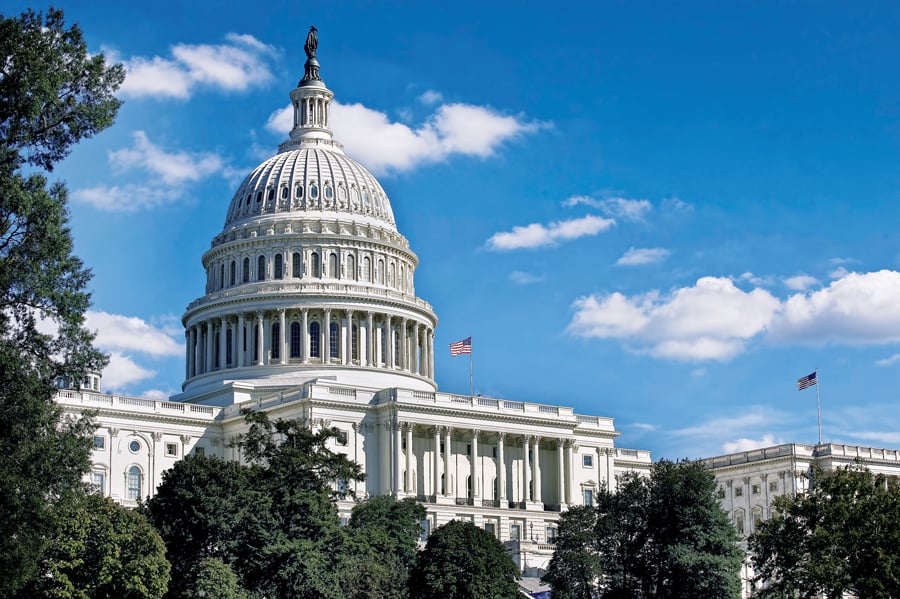

House Republican leaders took the first step Wednesday toward enacting trillions of dollars in tax cuts and raising the nation’s $36 trillion debt limit, offering a plan that risks rankling quarreling factions in the party.
The proposal aims to smooth the passage of President Donald Trump’s top legislative priorities: the extension of expiring individual and business taxes passed in 2017, boosting defense and border security spending and cuts to non-defense spending.
Passing any measure is far from certain, given Republicans’ narrow and fractious majority. Democrats are expected to be unified in opposition.
The budget would allow Congress’s tax-writing committees to increase the deficit by $4.5 trillion over 10 years to accommodate tax cuts.
The $4.5 trillion runway means that Republicans could only do a straight extension of Trump’s 2017 tax cuts. To make any other tax code changes — eliminating taxes on tips, or fulfilling any of Trump’s other campaign pledges — they’d need to find spending cuts or tax increases to offset the cost.
The plan requires at least $1.5 trillion in spending cuts over a decade in programs such as Medicaid health coverage for the poor and disabled, Obamacare subsidies for low-income families and food assistance. It also mandates a $300 billion increase in spending on defense, immigration enforcement and border security.
To mollify fiscal hawks, the plan would reduce the size of the tax cuts if Congress doesn’t meet a goal of cutting at least $2 trillion in spending.
The plan also would fast-track a $4 trillion increase in the debt ceiling, avoiding a catastrophic default on US payment obligations later this year.
Dozens of current GOP lawmakers are opposed to raising the debt ceiling on principle and have never voted to support an increase to the nation’s borrowing limit. Previous increases have required bipartisan support.
The debt ceiling came back into effect on Jan. 2 but the Treasury Department can avoid a default by employing accounting measures, possibly into the summer. By using the partisan budget reconciliation process, the GOP would deprive Democrats of any ability to use the debt ceiling deadline to extract concessions. Bills passed with this process cannot be filibustered in the Senate, effectively allowing passage by a simple majority rather than the usual 60 votes needed to end debate.
Speaker Mike Johnson’s budget plan could still fall short because of ongoing rifts in his party and a slim majority in which any two Republicans can team up with unified Democrats to defeat legislation.
The first step will be having the Budget Committee approve the plan on Thursday before a full House vote slated for the end of the month. If both the House and Senate approve the budget, then they must craft a bill that complies with the outline in order to enact the tax cuts and debt ceiling increase.
Johnson told reporters he will use the coming days to rally his conference behind the plan.
“This will unlock the process and get us moving, so we are excited about it,” he said. “We will need the week to work through it and talk to members.
A handful of fiscal hawks have demanded much larger cuts to non-defense spending in any tax cut bill, while a group of moderate Republicans have said they would not back deep cuts to programs like Medicaid, the government-funded health care program for people with low incomes.
The GOP also has been divided over how high to let the deficit go to accommodate tax cuts.
House Ways and Means Committee Chairman Jason Smith is pushing for as much flexibility as possible on the deficit in order to enact top Trump priorities like ending the tax on tipped wages. Flexibility may also be needed to satisfy a group of Republicans mostly from New York, New Jersey and California who want to see an end to the limit on the deduction of state and local taxes. Ending that limit would lead to bigger tax cuts for many property owners in their states.
Senate Republicans, frustrated by weeks of infighting among their House counterparts, are moving forward on their own scaled-back plan this week. The Senate plan would delay tax cuts for now and focus on providing hundreds of billions of dollars for defense and border security paid for by unspecified spending cuts elsewhere.
Johnson has pressed for combining all of Trump’s major priorities in a single package, arguing it would be harder for bitterly divided House Republicans to defect on an up-or-down vote on Trump’s agenda.
Democrats say the GOP plans show the party isn’t concerned with lowering the deficit but rather with cutting programs the poor rely upon to deliver tax cuts for the wealthy.
“This is a Republican betrayal of the middle class,” said House Budget Committee top Democrat Brendan Boyle. “There is nothing to bring costs down. But what they do have is $4.5 trillion of more debt.”
Without action by Congress, the lower tax individual rates and higher standard deduction enacted in 2017 will expire at the end of 2025. A host of business tax breaks related to capital expenditures, interest and pass-through companies will also disappear.

From outstanding individuals to innovative organizations, find out who made the final shortlist for top honors at the IN awards, now in its second year.

Cresset's Susie Cranston is expecting an economic recession, but says her $65 billion RIA sees "great opportunity" to keep investing in a down market.

“There’s a big pull to alternative investments right now because of volatility of the stock market,” Kevin Gannon, CEO of Robert A. Stanger & Co., said.

Sellers shift focus: It's not about succession anymore.

Platform being adopted by independent-minded advisors who see insurance as a core pillar of their business.
RIAs face rising regulatory pressure in 2025. Forward-looking firms are responding with embedded technology, not more paperwork.
As inheritances are set to reshape client portfolios and next-gen heirs demand digital-first experiences, firms are retooling their wealth tech stacks and succession models in real time.
